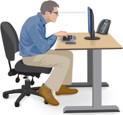Health and Safety Resources
Ontario Tech University is committed to providing the necessary supports to employees as they set up and maintain their workspace as part of the Flexible Workspace Program. The workspace should, to the extent possible, provide the same level of health, safety and security that an employee would receive at a regular work office. Employees working in a remote workspace are responsible for assessing that workspace for existing or potential problems and for taking corrective steps, in consultation with Health and Safety where appropriate.
In order to prevent the development of unsafe or unhealthy working conditions or practices, employees are advised to review the following information, complete the checklist and submit it to their manager along with their completed Flexible Workspace program request form.
Accident and Injury Reporting - Employees working remotely must immediately report any injuries that occur in the course of their employment during their workday.
Ergonomics
Employees must ensure their workspace is correctly setup to optimize proper ergonomics. Ontario Tech University supports the technology requirements for remote work. This includes the following:
- keyboard
- laptop
- monitor
- mouse
Note: The university will provide these assets only for either on-campus or remote workspace.
 The university also expects employees to manage their workday to ensure proper breaks are taken in order to minimize potential for musculoskeletal injury:
The university also expects employees to manage their workday to ensure proper breaks are taken in order to minimize potential for musculoskeletal injury:
- Every 20 minutes take a 20 second break and look 20 feet away to avoid eye fatigue.
- Avoid static posture for extended periods of time.
- Ensure proper alignment of your arms, wrists, shoulders and back.
- Ensure proper positioning of your monitor, keyboard and mouse.
- Ensure regular breaks are taken during the workday.
- Test your knowledge by selecting the picture and find the ergonomic errors.
Assessment Tools
Select the following to perform an assessment of your workspace.
Learn more about ergonomics on the university’s Ergonomics Program webpage.
Top 10 tips for computing comfort
- Position the top of your monitor screen at eye level. If you wear bifocal lenses, lower the monitor further and turn screen upward.
- Tilt your monitor back 10 to 20 degrees to keep the same focal length as your eyes scan from the top to bottom of screen. If using bifocals, use a 30 to 40 degree angle.
- Position your monitor no closer than 20" (50 cm) from your eyes. A good rule of thumb is an arm’s length distance. The larger a screen, the more distance you’ll want. When wearing bifocal lenses, the distance should be 16" (40 cm), matching the lenses’ focal length.
- Position your keyboard to the height of your elbow.
- Tilt your keyboard back slightly so that your wrists remain flat.
- Use a wrist rest so your hands and wrists remain relaxed.
- Rest your eyes periodically by focusing on an object 20 plus feet (6 plus metres) away.
- Use an easily adjusted chair, display mount and keyboard tray. Change the position of your display and keyboard to accommodate reflexive changes in your posture
- Stand and stretch your back and arms from time to time
- Stand more! Arrange your workstation so you can stand periodically while computing.
Work shouldn’t hurt
The MSD Prevention Guideline for Ontario provides a great deal of information that may also be of interest.
If you have questions about any of the content on this page, please reach out to healthandsafety@ontariotechu.ca.